Track marking – the Yarrangobilly experience
Canberra Speleological Society Inc.
Abstract
At Yarrangobilly Caves in New South Wales, track marking has been used in a number of wild caves for more than 30 years with the aim of limiting visitation impacts. In most cases, the marked tracks have been installed to reduce damage to calcite decoration, but they have also been used to protect bone material and to minimise impacts on sediment deposits. Over the years, a variety of materials has been used, ranging from green paint to reflective markers and wire lines. This paper briefly covers the history of track marking efforts, reviews the methods used and considers their effectiveness and impacts on the caves. It also draws some conclusions that may be useful in considering track marking projects in other areas.
Introduction.
This paper had its origins in brief discussions last year with several people in Central Queensland who were wondering how best to limit the impacts of foot traffic in some of their caves. They had been advised to mark out trails with reflective markers but had not considered other methods that could be more effective.
As various track marking methods have been tried in some of the wild caves at Yarrangobilly, I thought there would be value in sharing some of the insights gained over the last 30 to 40 years.
The setting
Yarrangobilly is a karst area within the Kosciuszko National Park in southeastern New South Wales. The area has more than 300 caves in a belt of Silurian limestone about 10km long and 1km wide. Many of the caves have significant speleothem development and some have important historical, biological or geoscientific values. Four caves have been developed as show caves. Most other caves can be accessed by recognised speleo groups under a permit system administered by locally-based National Parks and Wildlife (NPWS) staff. Some of the more sensitive caves are gated (Figure 1) - including all but one of the caves mentioned in this paper - and have limits on the number of visits per year. In some cases there are also restrictions on which parts of a cave may be visited. Visitors must report on their activities, but there is no system of approved trip leaders or in-cave supervision, so there is an element of trust in administering the access regime. That is to say, the effectiveness of any track marking efforts relies on cavers’ sense of responsibility and commitment to “caving softly”.
Typically, cave floors are a combination of breakdown, mud, gravels and bedrock with patches of flowstone, so they are susceptible to mud tracking and trampling.
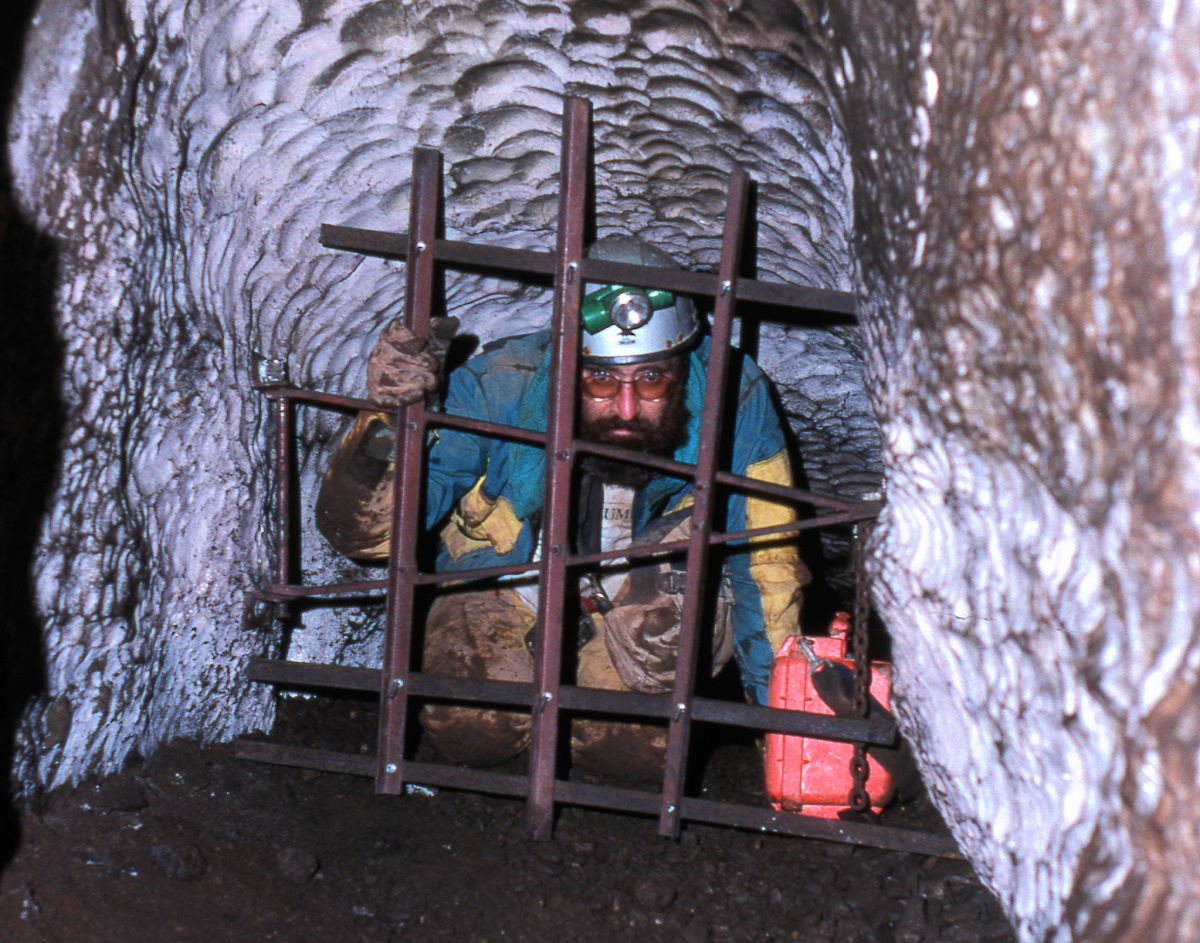
Figure 1: Gate in Eagles Nest Cave.
In the beginning …
The first record of track marking at Yarrangobilly appears to have been in 1966, when cavers noted the appearance of spray-painted arrows in Eagles Nest Cave (Dunkley, 1966) (Figure 2). It is not known who was responsible for these efforts, but a spray painted “Tom, Lin, Mel & Rick” probably gives us a clue. The arrows appear to have been intended as navigational aids rather than as cave protection measures. It is highly unlikely that the markings were officially approved.
Several years later, in 1970, paint made another appearance. This time it was in the newly discovered and highly decorated Janus Cave (Y58). Here, the markings were intended as a cave protection measure, but once again, it is highly unlikely the efforts were officially sanctioned.

Figure 2: Painted arrow in Flat Bed Cavern, Eagles Nest Cave.
The entrance to Janus Cave and the associated doline had been known for some time, but little attention was paid to it until 1969 – almost exactly 40 years ago – when an extension was discovered by the National University Caving Club - NUCC - (Webb, 1969). On the next trip several months later, the NUCC team discovered the large and spectacularly decorated Rawlinson Chamber (Alting, 1969) (Figure 3).
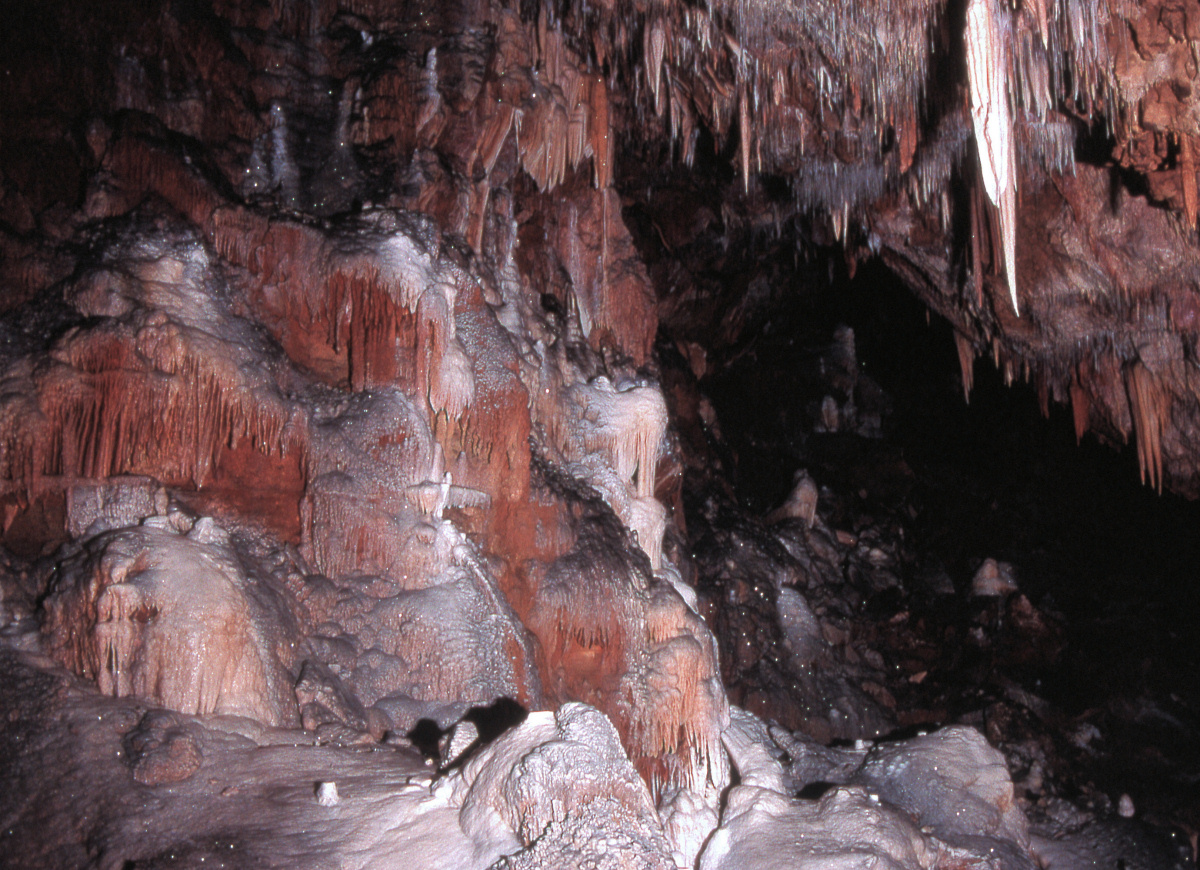
Figure 3:Rawlinson Chamber, Janus Cave
Rawlinson Chamber is a breakdown chamber about 100 metres long and 10 to 15 metres wide. Secondary calcite (flowstone) covers much of the floor (Figure 4), but in places this is just a thin crust on mud.

Figure 4:Flowstone cascade, Rawlinson Chamber, Janus Cave.
As knowledge of the beautiful chamber spread through the caving community, Janus Cave soon became a magnet for cavers. Unfortunately, the impacts of their visits rapidly became apparent as mud was released from under the flowstone and tracked around the chamber. Less than a year after its discovery, concerns were being voiced about the damage (Shepherd & Bell, 1970).
Before long, there was a well intentioned but completely misguided attempt to limit the damage by marking several trails around the chamber using green paint. As noted in the trip report, the party “painted several main trails in the Y58 chamber with green paint” (Mendum, 1970). Perhaps significantly, this was done on 1 April 1970. The paint trail comprised fist sized dabs every few metres (Counsell, 1971).
More serious efforts
The foundations for the marked tracks seen today in several wild caves at Yarrangobilly were laid in the 1970s and 1980s.
During the 1970s, Yarrangobilly was very popular with cavers. Many of the major caves were mapped, a range of cave studies were undertaken and there were many trips of a recreational nature. In short, there were many trips into some of the large and better decorated caves.
However, there were also increasing cave conservation and protection concerns and these led to the initiation of several track marking projects, largely at the behest of cavers.

Figure 5:Main chamber, Restoration Cave.
Restoration Cave (Figure 5) was the first cave to receive a measure of protection when a simple line of red plastic coated wire was strung around the most decorated part of the main chamber (Figure 6). When this was done, could not be ascertained, but it was before the end of 1971 (Counsell, 1971).
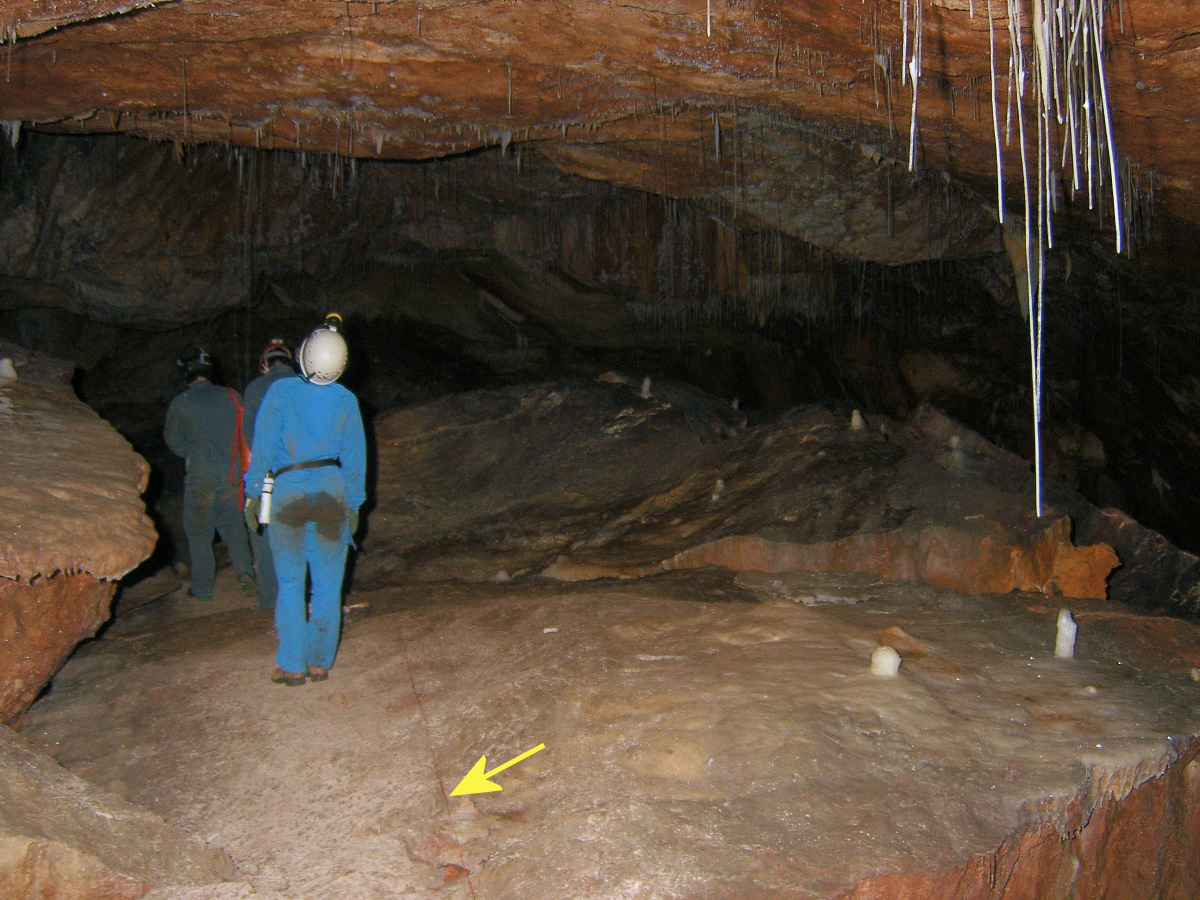
Figure 6:Wire line in Restoration Cave.
In the mid 1970s, the now defunct University of New South Wales Speleological Society (UNSWSS) undertook protection works in Eagles Nest and East Deep Creek Caves.
In Eagles Nest, UNSWSS initially used plastic covered wire to mark some of the route through Flatbed Cavern, the Railway Tunnel and the Crystal Stream and subsequently proposed a range of additional protection measures (Pavey 1974). Most of the UNSWSS proposals for marked routes (Figure 7), viewing areas and signs (Figure 8) were soon implemented (Warild, 1975).
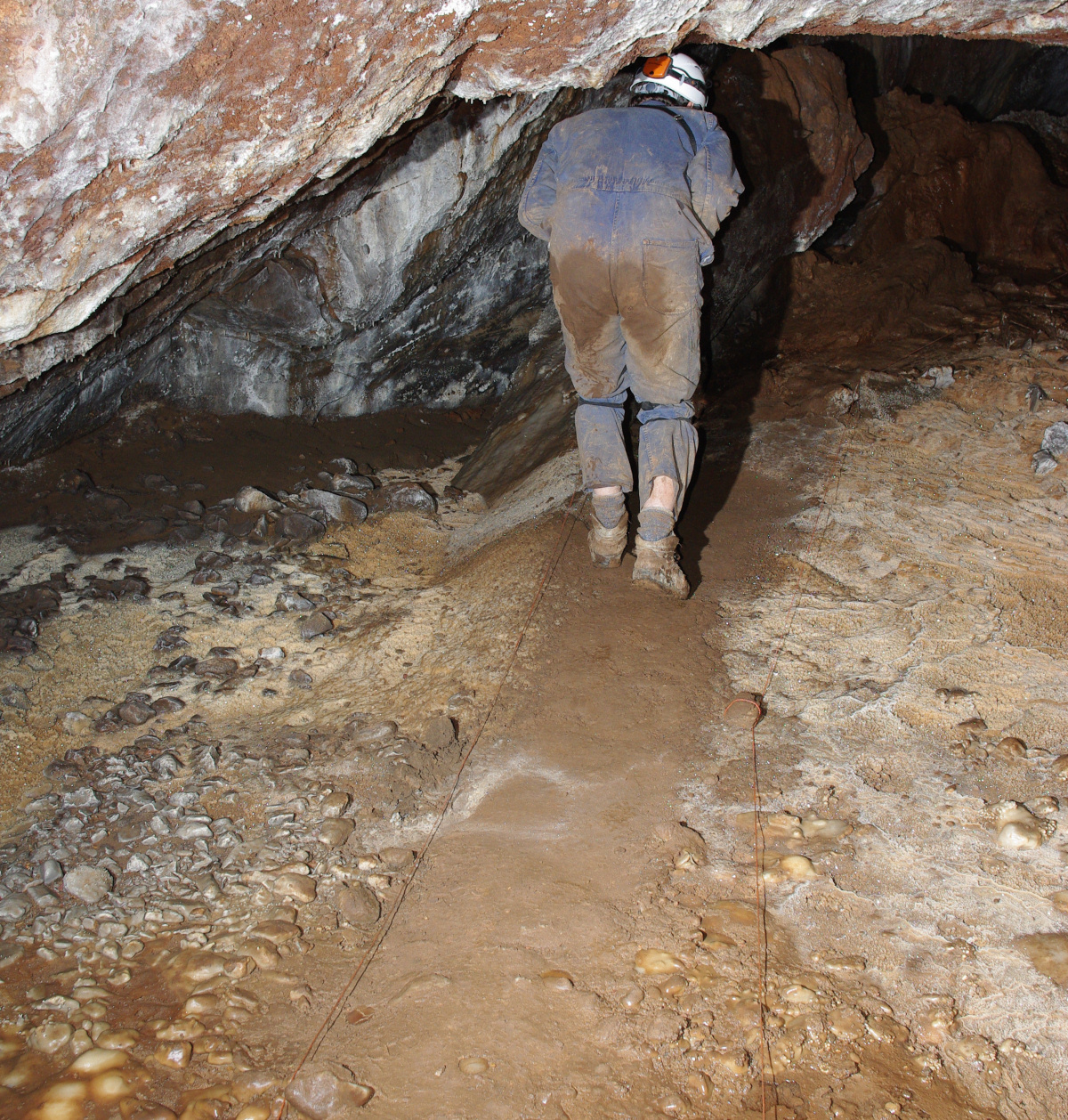
Figure 7:Marked track in the Crystal Stream area of Eagles Nest Cave.
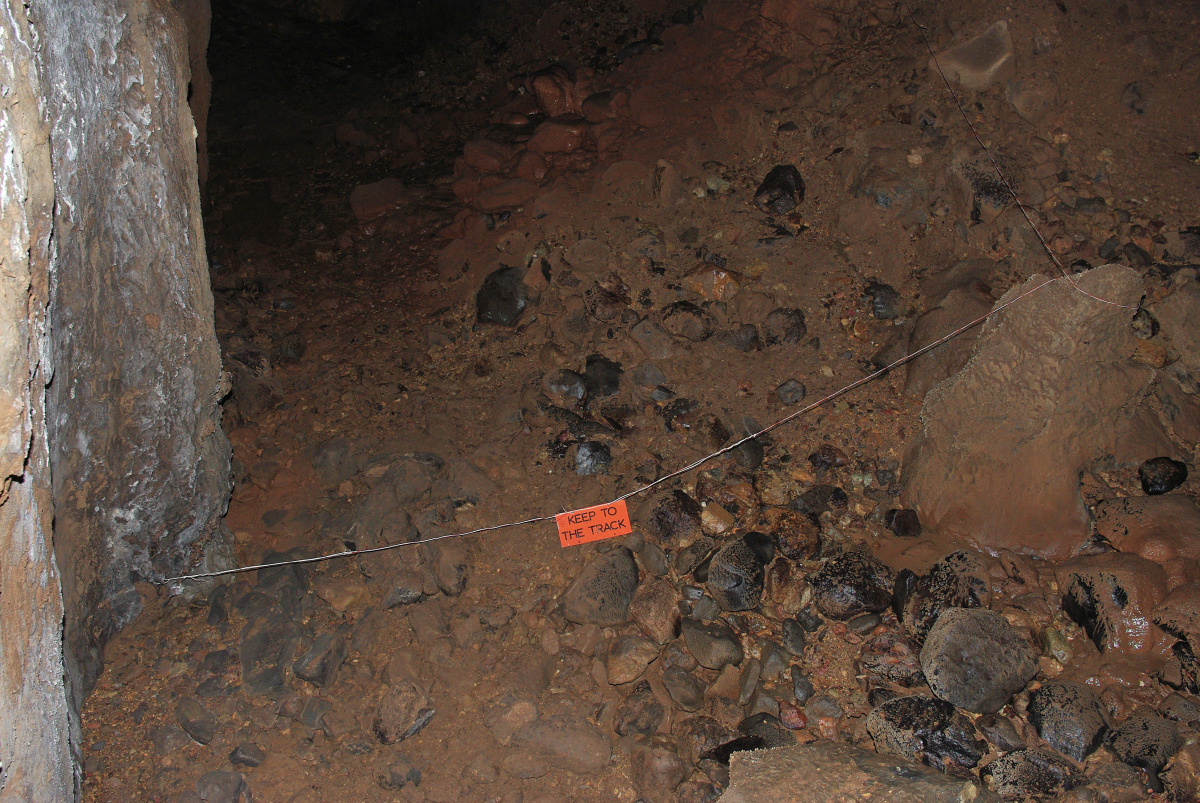
Figure 8:Marked track and sign, Railway Tunnel area, Eagles Nest Cave.
In East Deep Creek Cave, UNSWSS designated small changing areas and placed signs requesting that people remove dirty boots and overalls before entering highly decorated areas (Pavey, 1975). Although these did not involve track marking per se, they had the same intent.
During the 1970s, flagging tape was used in Eagles Nest and East Deep Creek to ‘fence off’ special features such as bone accumulations, drip holes and isolated patches of floor decoration.
In the late 1970s, the Capital Territory Caving Group, also now defunct, attempted to remove the green paint trails in Janus Cave. It then re-delineated the trails using small reflective markers that were affixed to the cave with an epoxy adhesive.

Figure 9:Flatbed Cavern area, Eagles Nest Cave. Note the in-grained mud on speleothems that dates prior to installation of the marked track.
By the early 1980s, it became apparent that the marked routes in Eagles Nest and Restoration Caves could be improved. The Canberra Speleological Society (CSS) submitted proposals to NPWS with the main focus on Eagles Nest where it wanted to use plastic coated wire to extend the route through the Railway Tunnel and Flat Bed Cavern areas, undertake clean up work (Dunn, 1981) (Figure 9) and to place a small footbridge (Figure 10) over some oolites and a crystal streamway (Brush, 1983). NPWS agreed to the works which were carried out by CSS through to 1984 (Coggan, 1984).

Figure 10:Footbridge in the Railway Tunnel, Eagles Nest Cave.
Only minor remedial work has been undertaken in Eagles Nest since the mid 1980s, but on a recent visit, a critical appraisal indicated there is scope to further improve the track. The wire lines are not continuous and it appears that cavers are going off track between the marked sections.
Janus Cave (Y58)
In 2000, CSS developed a proposal in conjunction with NPWS (Ingarfield, 2000) to redo the trails in Rawlinson Chamber of Janus Cave. The reflective markers, then 20 years old, were deteriorating and the epoxy was no longer holding firm. The proposal included:
- installing a continuous wire line without permanently disfiguring the cave (i.e. so that it could be removed without trace at a later date);
- ‘fencing off’ the principal features of Rawlinson Chamber, but providing visitors with reasonable viewing access;
- having regard to past usage patterns (i.e. directing visitors along routes that had already been established, where it was considered reasonable to do so);
- using a small number of signs to indicate the places where dirty clothing and footwear should be removed;
- removing all the old reflective markers; and
- cleaning selected parts of the cave, focussing on areas just beyond the wire lines to remove muddy tracks that visitors might be tempted to follow.
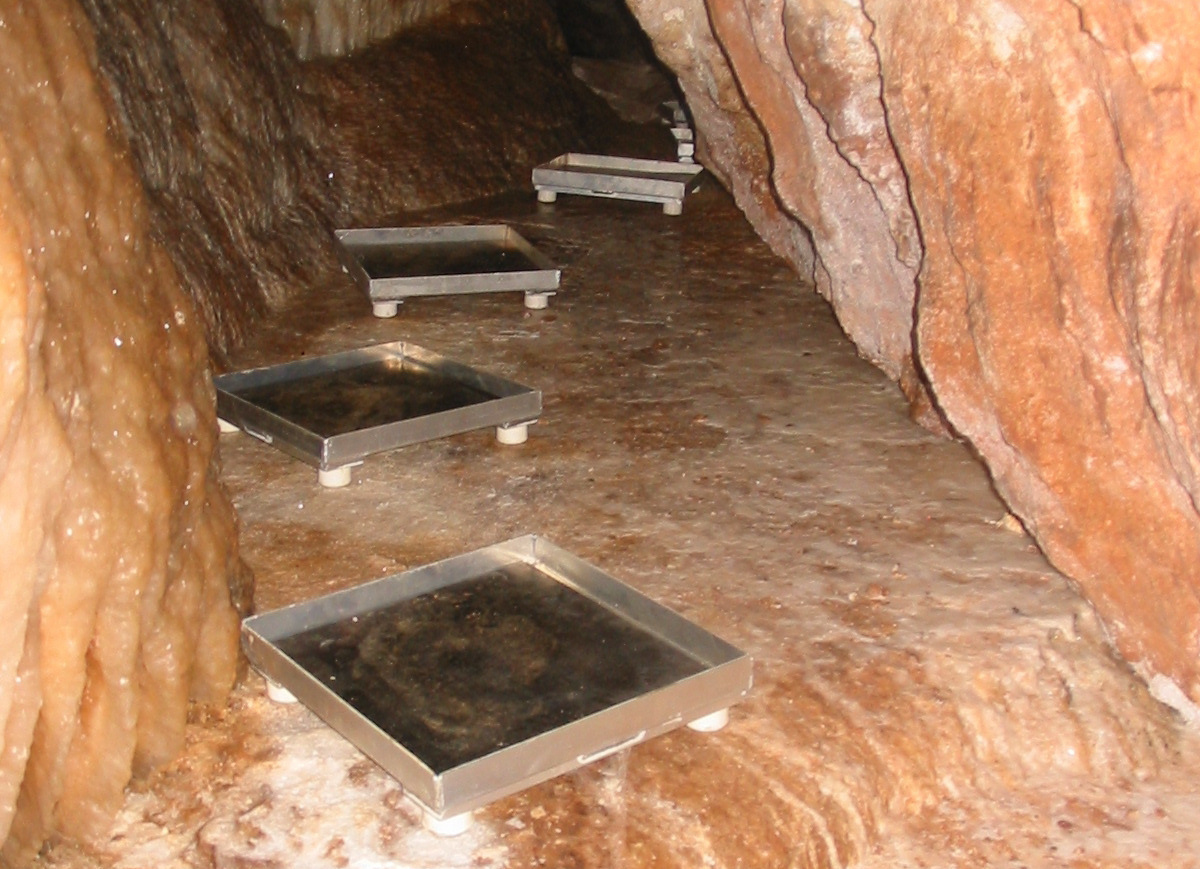
Figure 11:Aluminium and rubber stepping ‘stones’, Janus Cave.
As discussions with NPWS progressed, CSS also suggested some additional works including the replacement of plastic matting (actually pieces of carpet protection mat) along the crystal streamway. The streamway is the normal - and most practical - access route into Rawlinson Chamber and at times is very active, resulting in the plastic squares becoming cemented into the floor and any mud on them being washed onto the white calcite floor. CSS proposed replacing the mats with a series of 30cm square stainless steel ‘stepping stones’ with small white rubber feet to limit the area of contact with the floor (Figure 11).
NPWS approved the proposals and agreed to procure all the materials needed. However, in view of cost considerations, aluminium was used to fabricate the ‘stepping stones’ and, as suitable wire was not available, electric fencing line was purchased. This is a 3mm plastic cord with stainless steel wires woven into it (Figure 12).
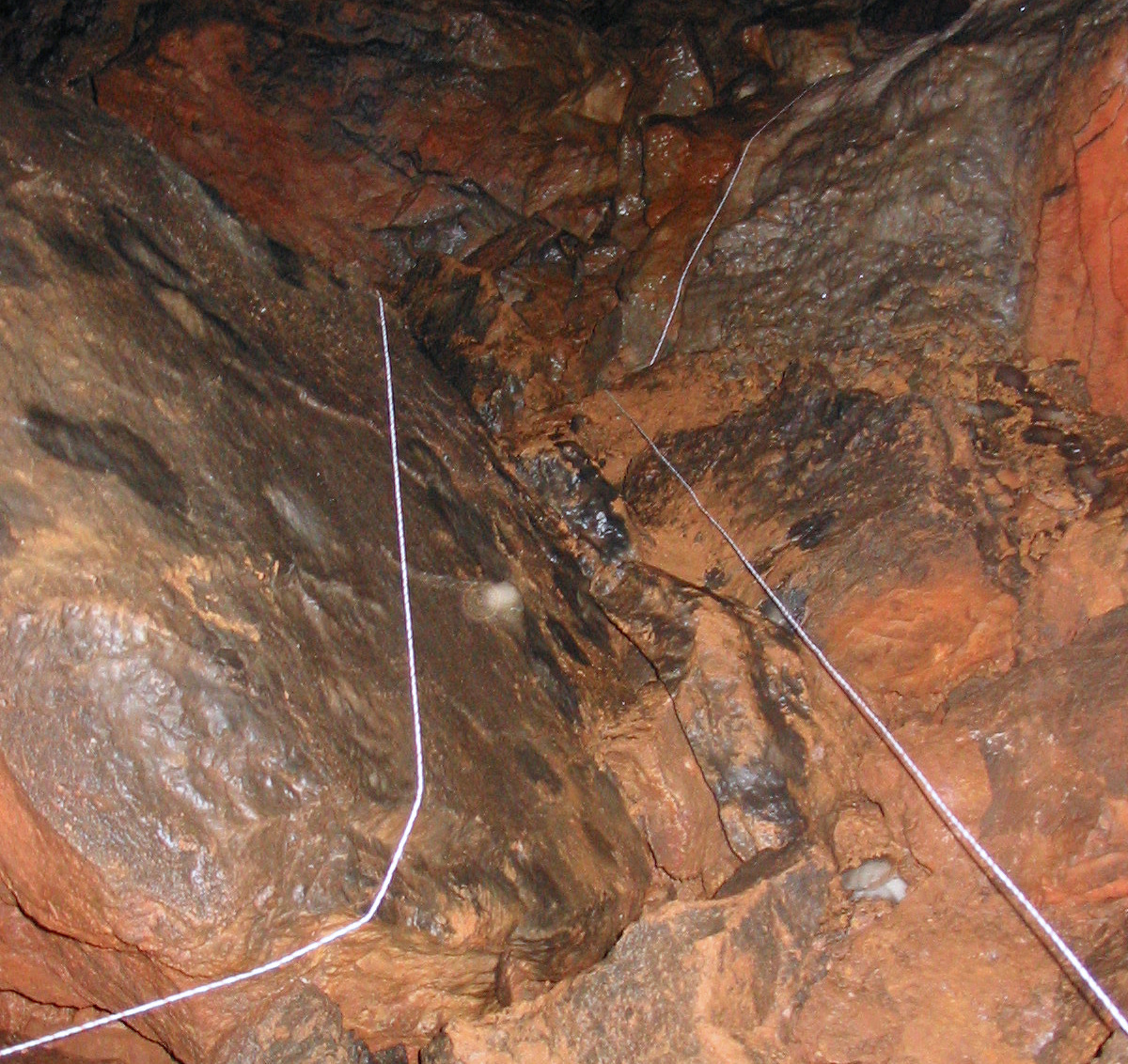
Figure 12:Route marked with electric fence cord, Rawlinson Chamber, Janus Cave.
The approved works were carried out during 2002 (Brush 2002a & b).
Following its successful use in Y58, electric fence cord was used for track enhancements in Restoration Cave (Figure 13).
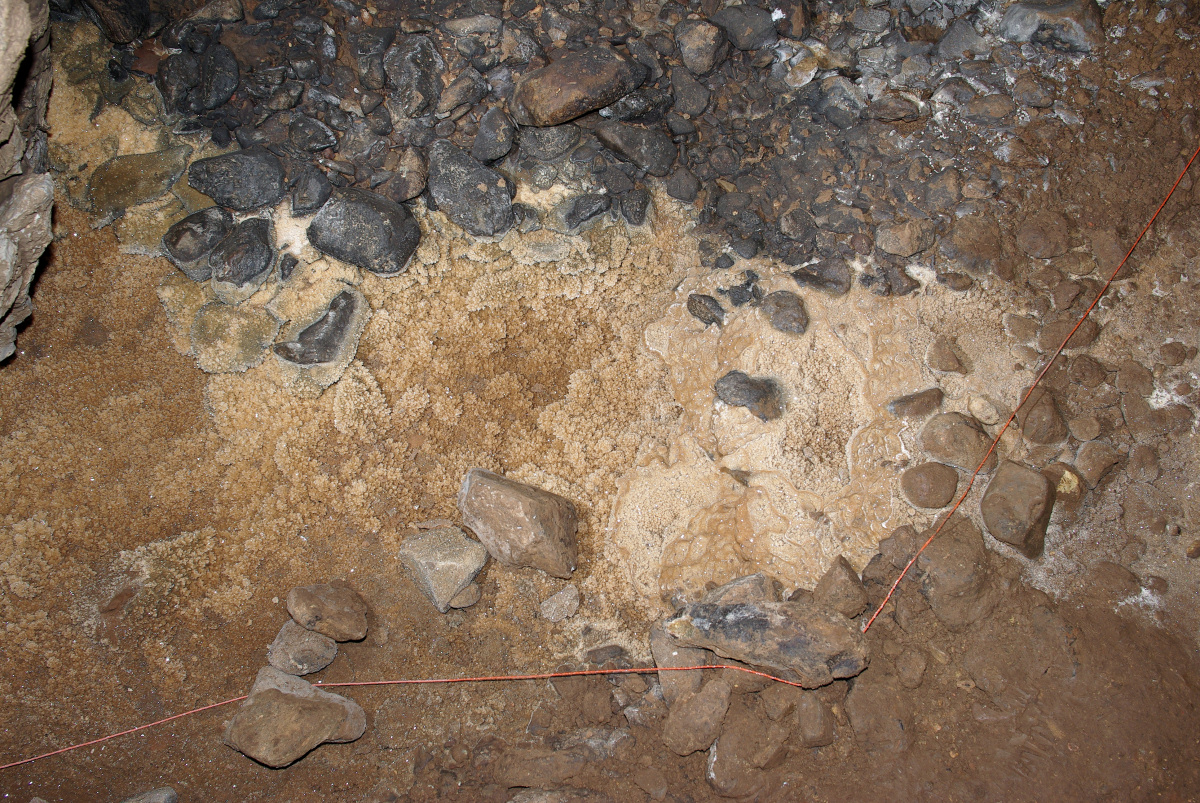
Figure 13:Electric fence cord in the lower level of Restoration Cave.
Cave impacts and durability of materials used
Paint obviously has considerable visual impact and while Hildreth-Werker et al (2006) note that it can break down quickly - which can be an issue in itself it is apparent in Eagles Nest that some of the painted arrows are still going strong after more than 40 years. There have been no concerted efforts to remove the paint for fear of further damaging the cave. Having said that, it appears the paint cleaning efforts in Y58 in the 1980s were reasonably successful.
The reflective tape markers in Y58 were attached with an epoxy adhesive. In a few places, the markers were on rods that were glued into holes drilled in the cave floor. So there was some permanent impact on the cave. Fortunately however, the epoxy had largely lost its grip after about 20 years. By then many of the markers had lost their reflective powers. As a further illustration of this problem, in Yongcheon Cave in Korea, which was discovered just 5 years ago, reflective markers are already showing signs of deterioration (Figure 14). Plastic retro-reflective discs have not been used at Yarrangobilly, but are likely to be more durable than reflective tape.

Figure 14:Trail markers in Yongcheon Cave, Jeju Island, Republic of Korea. Note the deterioration in the reflective material.
The aluminium stepping stones in Y58 appear to be reasonably durable, but they will need to be carefully monitored and replaced when they start to show signs of oxidation.
Flagging tape works reasonably well, at least in the short term. It can be tied to natural features in the cave (Figure 15), or simply laid out on the cave floor. However, observations in Eagles Nest indicate that it becomes brittle and breaks down into small (and unsightly) chips after just a few years. Once the tape becomes brittle, it is extremely difficult to remove all the pieces from the cave. This lack of durability is consistent with experience in the USA, where flagging tape is widely used for trail delineation (Hildreth-Werker et al, 2006), but as the authors note, although tape will last for up to a decade in some caves, in others it should be replaced every year or two.
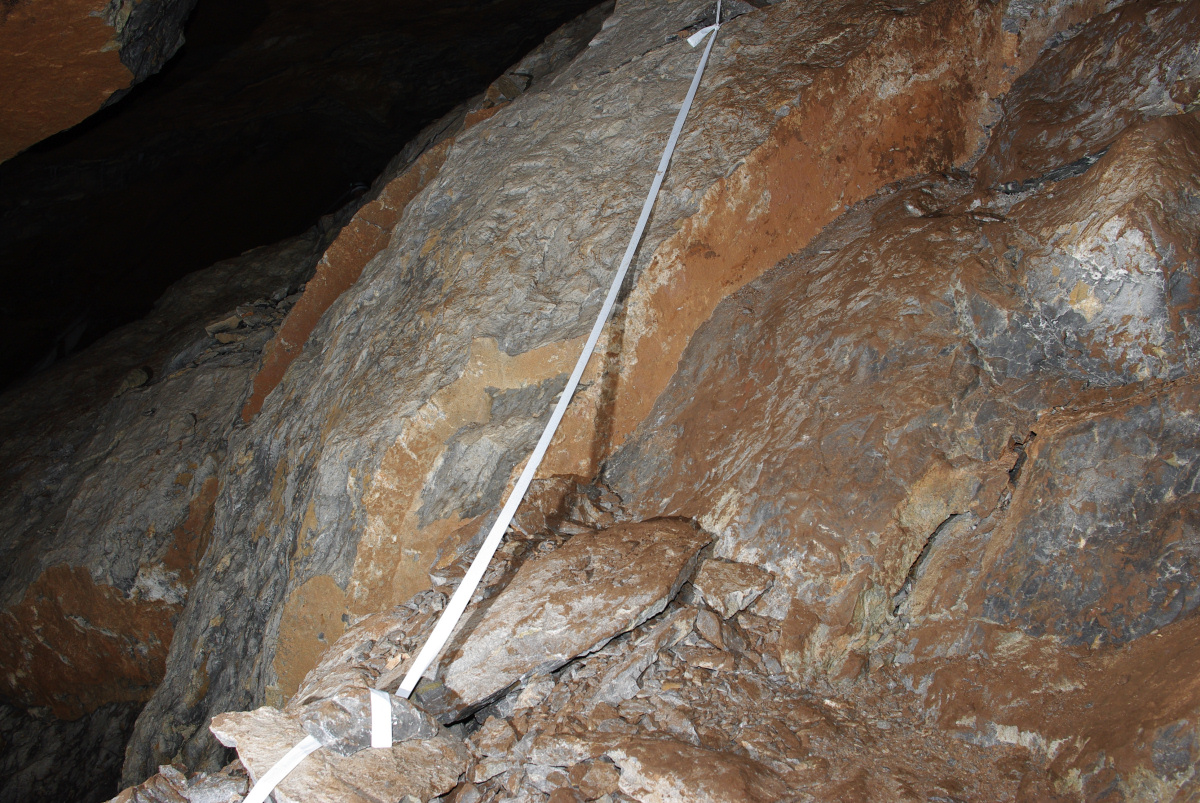
Figure 15:Flagging tape in use in Eagles Nest Cave.
All of the wire/cord lines at Yarrangobilly have been installed without permanently altering the caves. The lines are simply tied to convenient projections or wrapped around loose rocks on the floor. Plastic coated copper wire appears to be very durable and is not showing any significant signs of deterioration after periods of more than 30 years in the caves. The electric fence line has been in place for up to 7 years and is performing well so far. However, it will need to be closely monitored for any signs of deterioration in the plastic cord to ensure that it is removed from the cave before it breaks down.
Effectiveness of the various track marking methods
As indicated earlier, paint is, or can be, highly visible, but …
Reflective markers have been widely used in some parts of Australia (Poulter, 1987) and they are certainly very effective for indicating the general route (Figure 16). However, they can leave the route open to interpretation and lead to the track becoming wider over time and, as noted by Hildreth-Werker et al, (2006), can encourage visitors to wander off trail between markers. Free standing markers could also be moved around at will by visitors.
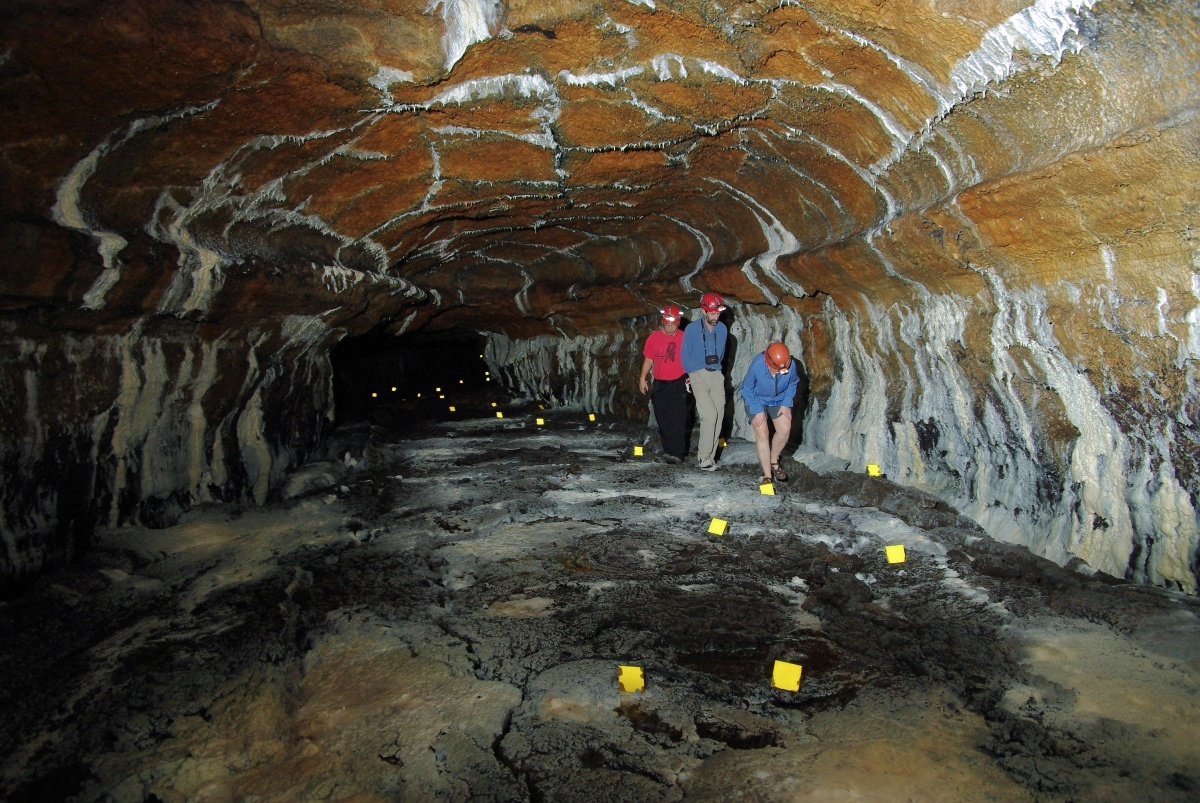
Figure 16:The removable reflective markers used in Yongcheon Cave, Korea are good for indicating a general route, but their wide spacing can leave the precise path open to interpretation.
Flagging tape is generally highly visible, depending on the colour used, but suffers from low tensile strength. Thus it is easily damaged if trodden on or walked into. This does happen.
Thin plastic coated wire is stronger than flagging tape but is less visible (Figure 17). This may be good from an aesthetic point of view and for photographers, but there is an increased likelihood of visitors walking into the line or over it without noticing. Twisted red and white bell wire works well because it stands out against a variety of backgrounds but does not detract from photos as much as flagging tape.
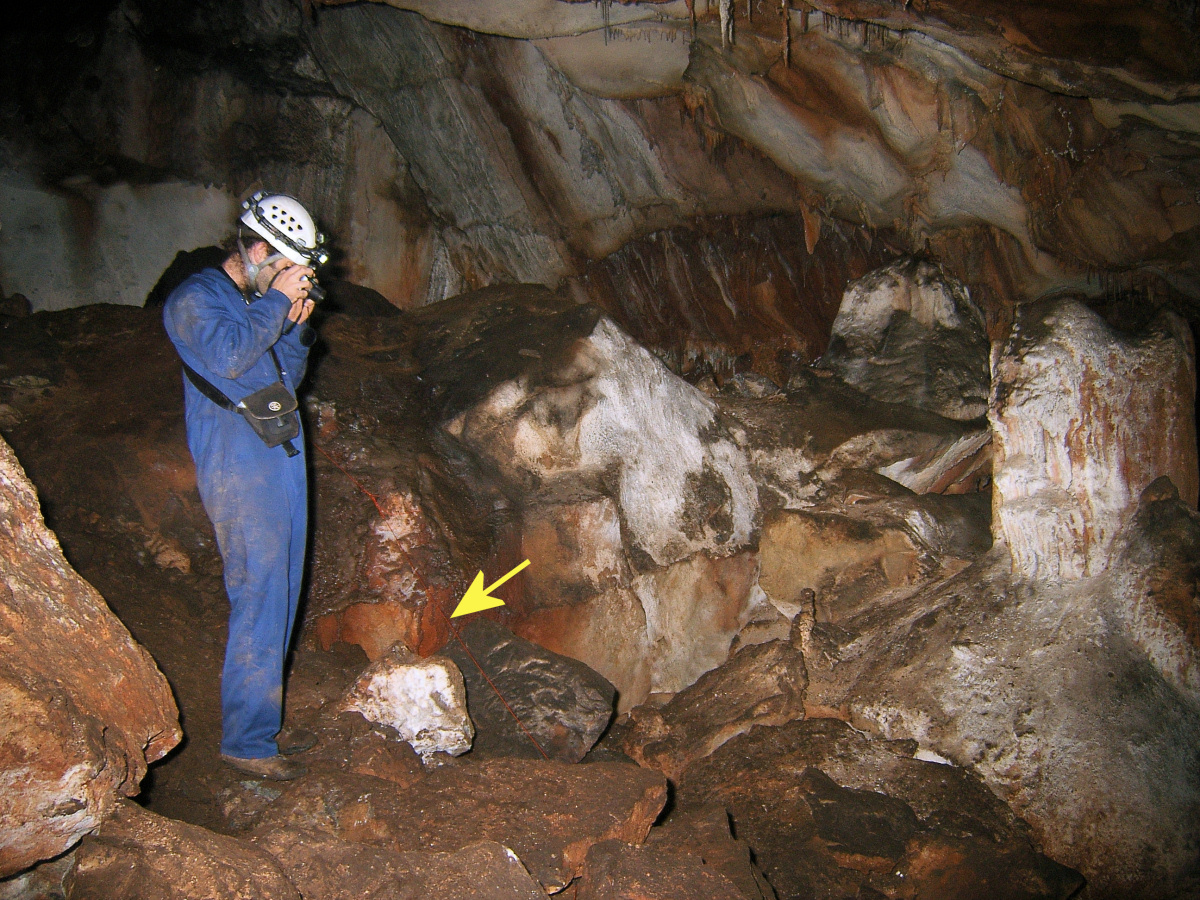
Figure 17:A subtle red wire line in Restoration Cave
Electric fence cord is reasonably visible - white and orange lines have been used at Yarrangobilly – but it can detract from photographs. The line is immensely strong and it is easily tied to convenient projections or loose rocks. It really does seem to be quite effective – even without energising the wires!
But do cave visitors at Yarrangobilly stick to the trails? The short answer appears to be sometimes. As noted above, the trails have been laid out for various reasons:
- to restrict the area of damage to calcite/flowstone floors;
- to minimise trampling of sediment deposits; and
- to reduce general mud tracking through caves.
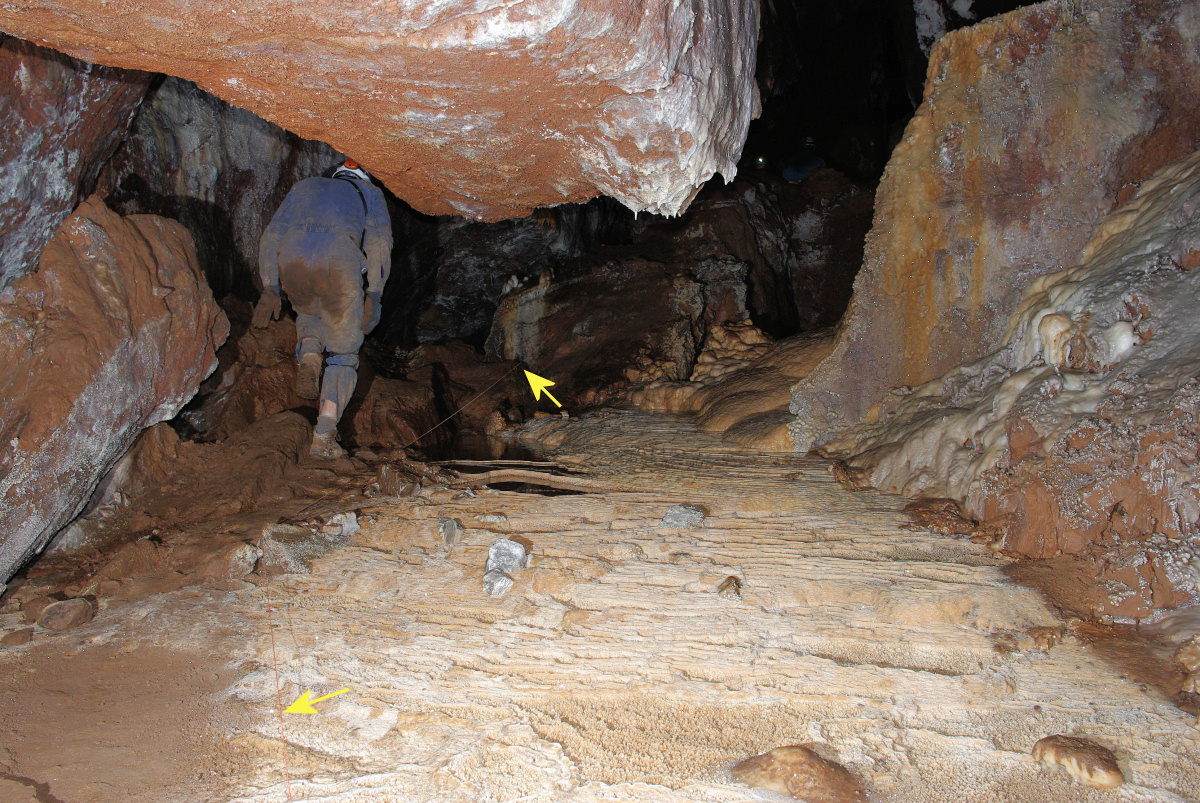
Figure 18:Crystal Stream, Eagles Nest Cave. The wire line has been in place since the mid 1970s.
It seems that where visitors perceive an area of decoration to be clean or delicate they stick to the track. For example, there are areas in Eagles Nest where the track is no wider today than it was 35 years ago (Figure 18). However, in other places, particularly on sediment banks, where visitors may perceive there is nothing worthy of protection, the marked trails are less effective. It appears to be a similar story in some of the breakdown chambers where the route is over large slabs of bare rock. For quite a few years after the route was marked out in this area in 1983-84, there was a muddy trail over the slabs bounded by a wire. Now however, the muddy trail has spread beyond the wire boundaries (Brush 2009) (Figure 19).

Figure 19:Flatbed Chamber, Eagles Nest Cave showing muddy trail extending beyond the track boundary.
Conclusions
Experience gained at Yarrangobilly over the last 30 and more years indicates track marking can be effective in restricted access caves, even though there is no system of approved trip leaders or other in-cave supervision. This is particularly so where there is a continuous line of wire or electric fence cord. Reflective markers can be useful for drawing attention to specific points on the line, but these markers are less effective when used alone and reflective tape can breakdown relatively quickly.
Marked routes work very well in areas of decoration, but are less effective in areas of breakdown, on bedrock or on sediments. In such areas, it appears visitors are less willing to keep to a marked route, especially if there are already footprints beyond the track. A problem that gets worse over time.
How can the effectiveness of the marked tracks in wild caves at Yarrangobilly be improved? There is probably no single solution, but it is suggested that a multi-pronged approach is used:
- more clearly delineating track margins;
- cleaning beyond the marked track;
- issuing track notes to each visiting party;
- giving specific instructions before entering a cave; and
- specifically excluding access to areas outside marked tracks unless there is a valid (and approved) reason for doing so.
Acknowledgements
This paper would not have been possible without the support of many people, including current and former NPWS staff at Yarrangobilly Caves and in particular George Bradford, the current Manager and Jo Vincent (nee Ingarfield), a former Manager. In addition, the assistance of various members of the Canberra Speleological Society Inc (CSS), who have worked on trail marking and cleaning projects at Yarrangobilly since the early 1980s, is gratefully acknowledged.
Most of the materials used in track marking projects at Yarrangobilly were supplied by the NSW National Parks and Wildlife Service.
References
Alting Mick (1969). Yarrangobilly trip report, 23-24 August 1969. Speleograffiti 6(5):9-10, September 1969, published by the National University Caving Club.
Dunn, RJ (1981) Yarrangobilly trip report 11-12 July 1981. Unpublished report in the Canberra Speleological Society library.
Brush, J (1983) Trip report, Yarrangobilly, 15-16 January 1983. Unpublished report in the Canberra Speleological Society library.
Brush, J (2002a) Janus Cave, Yarrangobilly (Y58), track delineation project, 16-17 March 2002. Unpublished report in the Canberra Speleological Society library and also lodged with NPWS.
Brush, J (2002b) Yarrangobilly trip report, 7-8 December 2002. Unpublished report in the Canberra Speleological Society library and also lodged with NPWS.
Brush, J (2009) Yarrangobilly - report on CSS trip, 17-18 January 2009. Unpublished report in the Canberra Speleological Society library and also lodged with NPWS.
Coggan, M (1984) Yarrangobilly trip report, 21-22 January 1984. Unpublished report in the Canberra Speleological Society library and also lodged with NPWS.
Counsell, Warwick (1971) Conservation inspection at Yarrangobilly. Spar 11:10, December 1971, published by the University of NSW Speleological Society.
Dunkley, J (1966) Yarrangobilly Trip – Easter 1966. SUSS Bulletin 6 (4):8-9, published by the Sydney University Speleological Society.
Hildreth-Werker, Val; Goodbar James and Werker, Jim C (2006) Trail delineation and signage in caves: reduce visitor impact. In: Cave Conservation and Restoration, 2006 Edition, published by the National Speleological Society, Huntsville Alabama, USA; pp175-185.
Ingarfield, J (2000) Summary of field trip to Janus Cave (Y58), 12 November 2000. (Unpublished NPWS document).
Mendum, J (1970) Yarrangobilly trip report, 27 March – 2 April, 1970. The Very Latest 5 (4):2-3, April 1970, published by the Canberra Speleological Society.
Shepherd, Phil & Bell, Maurice (1970) Editorial, Speleograffiti 7(1):3, March 1970, published by the National University Caving Club.
Pavey, A (1974) Eagles Nest – conservation. Spar 40:35-37, December 1974, , published by the University of NSW Speleological Society.
Pavey, A (1975) East Deep Creek Cave – Conservation. Spar 50:10-11, December 1975, published by the University of NSW Speleological Society.
Poulter, Norman (1987) Trail marking and area designation – a standard approach? Helictite, 25(2):51-53, published by the Speleological Research Council.
Warild, Alan (1975) It doesn’t always rain at Yarrangobilly, we just seem to go there at the wrong time (trip report, 4-6 October 1975). Spar 49:15, November 1975, published by the University of NSW Speleological Society.
Webb, Michael G (1969) Yarrangobilly trip report, Easter 1969. Speleograffiti 6(2):7, May 1969, published by the National University Caving Club.